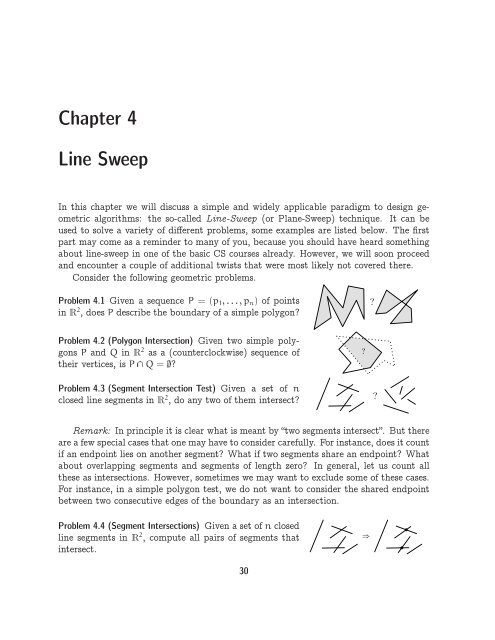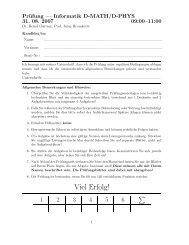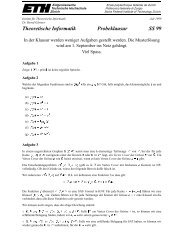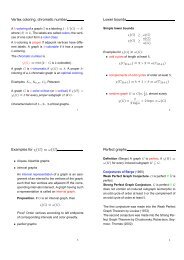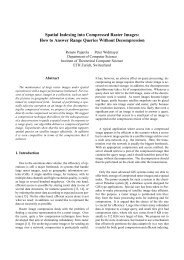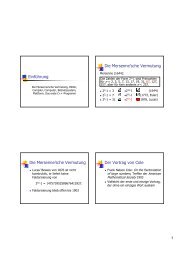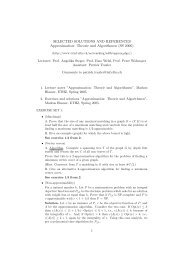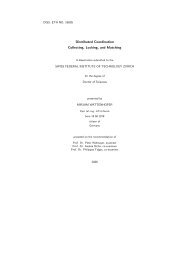Chapter 4 Line Sweep - TI
Chapter 4 Line Sweep - TI
Chapter 4 Line Sweep - TI
You also want an ePaper? Increase the reach of your titles
YUMPU automatically turns print PDFs into web optimized ePapers that Google loves.
<strong>Chapter</strong> 4<br />
<strong>Line</strong> <strong>Sweep</strong><br />
In this chapter we will discuss a simple and widely applicable paradigm to design geometric<br />
algorithms: the so-called <strong>Line</strong>-<strong>Sweep</strong> (or Plane-<strong>Sweep</strong>) technique. It can be<br />
used to solve a variety of different problems, some examples are listed below. The first<br />
part may come as a reminder to many of you, because you should have heard something<br />
about line-sweep in one of the basic CS courses already. However, we will soon proceed<br />
and encounter a couple of additional twists that were most likely not covered there.<br />
Consider the following geometric problems.<br />
Problem 4.1 Given a sequence P = (p1,...,pn) of points<br />
inR 2 , does P describe the boundary of a simple polygon?<br />
Problem 4.2 (Polygon Intersection) Given two simple polygons<br />
P and Q inR 2 as a (counterclockwise) sequence of<br />
their vertices, is P�Q =�?<br />
Problem 4.3 (Segment Intersection Test) Given a set of n<br />
closed line segments inR 2 , do any two of them intersect?<br />
Remark: In principle it is clear what is meant by “two segments intersect”. But there<br />
are a few special cases that one may have to consider carefully. For instance, does it count<br />
if an endpoint lies on another segment? What if two segments share an endpoint? What<br />
about overlapping segments and segments of length zero? In general, let us count all<br />
these as intersections. However, sometimes we may want to exclude some of these cases.<br />
For instance, in a simple polygon test, we do not want to consider the shared endpoint<br />
between two consecutive edges of the boundary as an intersection.<br />
Problem 4.4 (Segment Intersections) Given a set of n closed<br />
line segments in R 2 , compute all pairs of segments that<br />
intersect.<br />
30<br />
?<br />
⇒<br />
?<br />
?
CG 2012 4.1. Interval Intersections<br />
Problem 4.5 (Segment Arrangement) Given a set ofnclosed<br />
line segments in R 2 , construct the arrangement induced<br />
by S, that is, the subdivision ofR 2 induced by S.<br />
Problem 4.6 (Map Overlay) Given two setsSandT ofnand<br />
m, respectively, pairwise interior disjoint line segments in<br />
R 2 , construct the arrangement induced by S�T.<br />
In the following we will use Problem 4.4 as our flagship example.<br />
Trivial Algorithm. Test all the�n<br />
2�pairs of segments fromSinO(n 2 ) time and O(n) space.<br />
For Problem 4.4 this is worst-case optimal because there may by Ω(n 2 ) intersecting pairs.<br />
But in case that the number of intersecting pairs is, say, linear in n there is still hope<br />
to obtain a subquadratic algorithm. Given that there is a lower bound of Ω(n logn) for<br />
Element Uniqueness (Given x1,...,xn R, is there an i�= j such that xi = xj?) in the<br />
algebraic computation tree model, all we can hope for is an output-sensitive runtime of<br />
the form O(n logn+k), where k denotes the number of intersecting pairs (output size).<br />
4.1 Interval Intersections<br />
As a warmup let us consider the corresponding problem inR 1 .<br />
Problem 4.7 Given a set I of n intervals [ℓi,ri]�R, 1�i�n. Compute all pairs of<br />
intervals from I that intersect.<br />
Theorem 4.8 Problem 4.7 can be solved in O(n logn+k) time and O(n) space, where<br />
k is the number of intersecting pairs from�I<br />
2�.<br />
Proof. First observe that two real intervals intersect if and only if one contains the right<br />
endpoint of the other.<br />
£<br />
Sort the set {(ℓi,0)|1�i�n}�{(ri,1)|1�i�n} in increasing lexicographic order<br />
and denote the resulting sequence by P. Store along with each point from P its origin<br />
(i). Walk through P from start to end while maintaining a list L of intervals that contain<br />
the current point p P.<br />
Whenever p = (ℓi,0), 1�i�n, insert i into L. Whenever p = (ri,1), 1�i�n,<br />
remove i from L and then report for all j L the pair {i,j} as intersecting.<br />
4.2 Segment Intersections<br />
How can we transfer the (optimal) algorithm for the corresponding problem inR 1 to the<br />
plane? InR 1 we moved a point from left to right and at any point resolved the situation<br />
locally around this point. More precisely, at any point during the algorithm, we knew all<br />
31<br />
⇒<br />
⇒
<strong>Chapter</strong> 4. <strong>Line</strong> <strong>Sweep</strong> CG 2012<br />
intersections that are to the left of the current (moving) point. A point can be regarded<br />
a hyperplane inR 1 , and the corresponding object inR 2 is a line.<br />
General idea. Move a line ℓ (so-called sweep line) from left to right over the plane, such<br />
that at any point during this process all intersections to the left of ℓ have been reported.<br />
<strong>Sweep</strong> line status. The list of intervals containing the current point corresponds to a list L<br />
of segments (sorted by y-coordinate) that intersect the current sweep line ℓ. This list L is<br />
called sweep line status (SLS). Considering the situation locally around L, it is obvious<br />
that only segments that are adjacent in L can intersect each other. This observation<br />
allows to reduce the overall number of intersection tests, as we will see. In order to<br />
allow for efficient insertion and removal of segments, the SLS is usually implemented as<br />
a balanced binary search tree.<br />
Event points. The order of segments in SLS can change at certain points only: whenever<br />
the sweep line moves over a segment endpoint or a point of intersection of two segments<br />
from S. Such a point is referred to as an event point (EP) of the sweep. Therefore we<br />
can reduce the conceptually continuous process of moving the sweep line over the plane<br />
to a discrete process that moves the line from EP to EP. This discretization allows for<br />
an efficient computation.<br />
At any EP several events can happen simultaneously: several segments can start<br />
and/or end and at the same point a couple of other segments can intersect. In fact<br />
the sweep line does not even make a difference between any two event points that have<br />
the same x-coordinate. To properly resolve the order of processing, EPs are considered<br />
in lexicographic order and wherever several events happen at a single point, these are<br />
considered simultaneously as a single EP. In this light, the sweep line is actually not a<br />
line but an infinitesimal step function (see Figure 4.1).<br />
Event point schedule. In contrast to the one-dimensional situation, in the plane not all<br />
EP are known in advance because the points of intersection are discovered during the<br />
algorithm only. In order to be able to determine the next EP at any time, we use a<br />
priority queue data structure, the so-called event point schedule (EPS).<br />
Along with every EP p store a list end(p) of all segments that end at p, a list begin(p)<br />
of all segments that begin at p, and a list int(p) of all segments in SLS that intersect at<br />
p a segment that is adjacent to it in SLS.<br />
Along with every segment we store pointers to all its appearances in an int(¡) list of<br />
some EP. As a segment appears in such a list only if it intersects one of its neighbors<br />
32
CG 2012 4.2. Segment Intersections<br />
1<br />
2<br />
3<br />
4<br />
5<br />
p<br />
(a) Before.<br />
5<br />
6<br />
3<br />
7<br />
2<br />
1<br />
2<br />
3<br />
4<br />
5<br />
p<br />
(b) After.<br />
Figure 4.1: Handling an event point p. Ending segments are shown red (dashed),<br />
starting segments green (dotted), and passing segments blue (solid).<br />
there, every segment needs to store at most two such pointers.<br />
Invariants.<br />
1. L is the sequence of segments from S that intersect ℓ, ordered by y-coordinate of<br />
their point of intersection.<br />
2. E contains all endpoints of segments from S and all points where two segments that<br />
are adjacent in L intersect to the right of ℓ.<br />
3. All pairs from�S<br />
2�that intersect to the left of ℓ have been reported.<br />
Event point handling. An EP p is processed as follows.<br />
1. If end(p)�int(p) =�, localize p in L.<br />
2. Report all pairs of segments from end(p)�begin(p)�int(p) as intersecting.<br />
3. Remove all segments in end(p) from L.<br />
4. Reverse the subsequence in L that is formed by the segments from int(p).<br />
5. Insert segments from begin(p) into L, sorted by slope.<br />
6. Test the topmost and bottommost segment in L from begin(p)�int(p) for intersection<br />
with its successor and predecessor, respectively, and update EP if necessary.<br />
33<br />
5<br />
6<br />
3<br />
7<br />
2
<strong>Chapter</strong> 4. <strong>Line</strong> <strong>Sweep</strong> CG 2012<br />
Updating EPS. Insert an EP p corresponding to an intersection of two segments s and<br />
t. Without loss of generality let s be above t at the current position of ℓ.<br />
1. If p does not yet appear in E, insert it.<br />
2. If s is contained in an int(¡) list of some other EP q, where it intersects a segment<br />
t from above: Remove both s and t from the int(¡) list of q and possibly remove<br />
q from E (if end(q)�begin(q)�int(q) =�). Proceed analogously in case that t<br />
is contained in an int(¡) list of some other EP, where it intersects a segment from<br />
below.<br />
3. Insert s and t into int(p).<br />
<strong>Sweep</strong>.<br />
1. Insert all segment endpoints into begin(¡)/end(¡) list of a corresponding EP in E.<br />
2. As long as E�=�, handle the first EP and then remove it from E.<br />
Runtime analysis. Initialization: O(n logn). Processing of an EP p:<br />
O(#intersecting pairs+|end(p)| logn+|int(p)|+|begin(p)| logn+logn).<br />
In total: O(k+n logn+k logn) = O((n+k) logn), where k is the number of intersecting<br />
pairs in S.<br />
£<br />
Space analysis. Clearly |S|�n. At begin we have |E|�2n and |S| = 0. Furthermore the<br />
number of additional EPs corresponding to points of intersection is always bounded by<br />
2|S|. Thus the space needed is O(n).<br />
£<br />
Theorem 4.9 Problem 4.4 and Problem 4.5 can be solved in O((n+k) logn) time and<br />
O(n) space.<br />
Theorem 4.10 Problem 4.1, Problem 4.2 and Problem 4.3 can be solved in O(n logn)<br />
time and O(n) space.<br />
Exercise 4.11 Flesh out the details of the sweep line algorithm for Problem 4.2 that is<br />
referred to in Theorem 4.10. What if you have to construct the intersection rather<br />
than just to decide whether or not it is empty?<br />
Exercise 4.12 You are given n axis–parallel rectangles in R 2 with their bottom sides<br />
lying on the x–axis. Construct their union in O(n logn) time.<br />
34
CG 2012 4.3. Improvements<br />
4.3 Improvements<br />
The basic ingredients of the line sweep algorithm go back to work by Bentley and<br />
Ottmann [2] from 1979. The particular formulation discussed here, which takes all<br />
possible degeneracies into account, is due to Mehlhorn and Näher [9].<br />
Theorem 4.10 is obviously optimal for Problem 4.3, because this is just the 2dimensional<br />
generalization of Element Uniqueness (see Section 1.1). One might suspect<br />
there is also a similar lower bound of Ω(n logn) for Problem 4.1 and Problem 4.2.<br />
However, this is not the case: Both can be solved in O(n) time, albeit using a very<br />
complicated algorithm of Chazelle [4] (the famous triangulation algorithm).<br />
Similarly, it is not clear whyO(n logn+k) time should not be possible in Theorem 4.9.<br />
Indeed this was a prominent open problem in the 1980’s that has been solved in several<br />
steps by Chazelle and Edelsbrunner in 1988. The journal version of their paper [5]<br />
consists of 54 pages and the space usage is suboptimal O(n+k).<br />
Clarkson and Shor [6] and independently Mulmuley [10, 11] described randomized<br />
algorithms with expected runtime O(n logn+k) using O(n) and O(n+k), respectively,<br />
space.<br />
An optimal deterministic algorithm, with runtime O(n logn + k) and using O(n)<br />
space, is known since 1995 only due to Balaban [1].<br />
4.4 Algebraic degree of geometric primitives<br />
We already have encountered different notions of complexity during this course: We can<br />
analyze the time complexity and the space complexity of algorithms and both usually<br />
depend on the size of the input. In addition we have seen examples of output-sensitive<br />
algorithms, whose complexity also depends on the size of the output. In this section,<br />
we will discuss a different kind of complexity that is the algebraic complexity of the<br />
underlying geometric primitives. In this way, we try to shed a bit of light into the<br />
bottom layer of geometric algorithms that is often swept under the rug because it consists<br />
of constant time operations only. But it would be a mistake to disregard this layer<br />
completely, because in most—if not every—real world application it plays a crucial role<br />
and the value of the constants involved can make a big difference.<br />
In all geometric algorithms there are some fundamental geometric predicates and/or<br />
constructions on the bottom level. Both are operations on geometric objects, the difference<br />
is only in the result: The result of a construction is a geometric object (for instance,<br />
the point common to two non-parallel lines), whereas the result of a predicate is Boolean<br />
(true or false).<br />
Geometric predicates and constructions in turn are based on fundamental arithmetic<br />
operations. For instance, we formulated planar convex hull algorithms in terms of an<br />
orientation predicate—given three points p,q,r R 2 , is r strictly to the right of the oriented<br />
line pr— which can be implemented using multiplication and addition/subtraction<br />
of coordinates/numbers. When using limited precision arithmetic, it is important to keep<br />
35
<strong>Chapter</strong> 4. <strong>Line</strong> <strong>Sweep</strong> CG 2012<br />
an eye on the size of the expressions that occur during an evaluation of such a predicate.<br />
In Exercise 3.22 we have seen that the orientation predicate can be computed by<br />
evaluating a polynomial of degree two in the input coordinates and, therefore, we say<br />
that<br />
Proposition 4.13 The rightturn/orientation predicate for three points inR 2 has algebraic<br />
degree two.<br />
The degree of a predicate depends on the algebraic expression used to evaluate it. Any<br />
such expression is intimately tied to the representation of the geometric objects used.<br />
Where not stated otherwise, we assume that geometric objects are represented as described<br />
in Section 1.2. So in the proposition above we assume that points are represented<br />
using Cartesian coordinates. The situation might be different, if, say, a polar<br />
representation is used instead.<br />
But even once a representation is agreed upon, there is no obvious correspondence<br />
to an algebraic expression that describes a given predicate. There are many different<br />
ways to form polynomials over the components of any representation, but it is desirable<br />
to keep the degree of the expression as small as possible. Therefore we define the (algebraic)<br />
degree of a geometric predicate or construction as the minimum degree of a<br />
polynomial that defines it. So there still is something to be shown in order to complete<br />
Proposition 4.13.<br />
Exercise 4.14 Show that there is no polynomial of degree at most one that describes<br />
the orientation test inR 2 .<br />
Hint: Let p = (0,0), q = (x,0), and r = (0,y) and show that there is no linear<br />
function in x and y that distinguishes the region where pqr form a rightturn from<br />
its complement.<br />
The degree of a predicate corresponds to the size of numbers that arise during its<br />
evaluation. If all input coordinates are k-bit integers then the numbers that occur during<br />
an evaluation of a degree d predicate on these coordinates are of size about 1 dk. If the<br />
number type used for the computation can represent all such numbers, the predicate<br />
can be evaluated exactly and thus always correctly. For instance, when using a standard<br />
IEEE double precision floating point implementation which has a mantissa length of 53<br />
bit then the above orientation predicate can be evaluated exactly if the input coordinates<br />
are integers between 0 and 2 25 , say.<br />
Let us now get back to the line segment intersection problem. It needs a few new<br />
geometric primitives: most prominently, constructing the intersection point of two line<br />
segments.<br />
1 It is only about dk because not only multiplications play a role but also additions. As a rule of thumb,<br />
a multiplication may double the bitsize, while an addition may increase it by one.<br />
36
CG 2012 4.4. Algebraic degree of geometric primitives<br />
Two segments. Given two line segments s = λa+(1−λ)b,λ [0,1] and t = µc+(1−<br />
µ)d,µ [0,1], it is a simple exercise in linear algebra to compute s�t. Note that s�t<br />
is either empty or a single point or a line segment.<br />
For a = (ax,ay), b = (bx,by), c = (cx,cy), and d = (dx,dy) we obtain two linear<br />
equations in two variables λ and µ.<br />
λax +(1−λ)bx = µcx +(1−µ)dx<br />
λay +(1−λ)by = µcy +(1−µ)dy<br />
Rearranging terms yields<br />
λ(ax −bx)+µ(dx −cx) = dx −bx<br />
λ(ay −by)+µ(dy −cy) = dy −by<br />
Assuming that the lines underlying s and t have distinct slopes (that is, they are neither<br />
identical nor parallel) we have<br />
ay 1 0<br />
−bx dx −cx bx by 1 0<br />
D =¬ax<br />
0<br />
ay −by dy −cy¬=¬ax<br />
cx cy 0 1<br />
dx dy 0 1¬�=<br />
and using Cramer’s rule<br />
λ = 1<br />
D¬dx −bx dx −cx<br />
dy −by dy −cy¬and µ = 1<br />
D¬ax −bx dx −bx<br />
ay −by dy −by¬.<br />
To test if s and t intersect, we can—after having sorted out the degenerate case in<br />
which both segments have the same slope—compute λ and µ and then check whether<br />
λ,µ [0,1].<br />
Observe that both λ and D result from multiplying two differences of input coordinates.<br />
Computing the x-coordinate of the point of intersection via bx + λ(ax − bx)<br />
uses another multiplication. Overall this computation yields a fraction whose numerator<br />
is a polynomial of degree three in the input coordinates and whose denominator is a<br />
polynomial of degree two in the input coordinates.<br />
In order to maintain the sorted order of event points in the EPS, we need to compare<br />
event points lexicographically. In case that both are intersection points, this amounts<br />
to comparing two fractions of the type discussed above. In order to formulate such a<br />
comparison as a polynomial, we have to cross-multiply the denominators, and so obtain<br />
a polynomial of degree 3+2 = 5. It can be shown (but we will not do it here) that this<br />
bound is tight and so we conclude that<br />
Proposition 4.15 The algebraic degree of the predicate that compares intersection points<br />
of line segments lexicographically is five.<br />
37
<strong>Chapter</strong> 4. <strong>Line</strong> <strong>Sweep</strong> CG 2012<br />
Therefore the coordinate range in which this predicate can be evaluated exactly using<br />
IEEE double precision numbers shrinks down to integers between 0 and about 2 10 =<br />
1 024.<br />
Exercise 4.16 What is the algebraic degree of the predicate checking whether two line<br />
segments intersect? (Above we were interested in the actual intersection point,<br />
but now we consider the predicate that merely answers the question whether two<br />
segments intersect or not by yes or no).<br />
Exercise 4.17 What is the algebraic degree of the InCircle predicate? More precisely,<br />
you are given three points p,q,r in the plane that define a circle C and a fourth<br />
point s. You want to know if s is inside C or not. What is the degree of the<br />
polynomial(s) you need to evaluate to answer this question?<br />
4.5 Red-Blue Intersections<br />
Although the Bentley-Ottmann sweep appears to be rather simple, its implementation<br />
is not straightforward. For once, the original formulation did not take care of possible<br />
degeneracies—as we did in the preceding section. But also the algebraic degree of the<br />
predicates used is comparatively high. In particular, comparing two points of intersection<br />
lexicographically is a predicate of degree five, that is, in order to compute it, we need to<br />
evaluate a polynomial of degree five. When evaluating such a predicate with plain floating<br />
point arithmetic, one easily gets incorrect results due to limited precision roundoff errors.<br />
Such failures frequently render the whole computation useless. The line sweep algorithm<br />
is problematic in this respect, as a failure to detect one single point of intersection often<br />
implies that no other intersection of the involved segments to the right is found.<br />
In general, predicates of degree four are needed to construct the arrangement of line<br />
segments because one needs to determine the orientation of a triangle formed by three<br />
segments. This is basically an orientation test where two points are segment endpoints<br />
and the third point is an intersection point of segments. Given that the coordinates of<br />
the latter are fractions, whose numerator is a degree three polynomial and the common<br />
denominator is a degree two polynomial, we obtain a degree four polynomial overall.<br />
Motivated by the Map overlay application we consider here a restricted case. In the<br />
red-blue intersection problem, the input consists of two sets R (red) and B (blue) of<br />
segments such that the segments in each set are interior-disjoint, that is, for any pair of<br />
distinct segments their relative interior is disjoint. In this case there are no triangles of<br />
intersecting segments, and it turns out that predicates of degree two suffice to construct<br />
the arrangement. This is optimal because already the intersection test for two segments<br />
is a predicate of degree two.<br />
Predicates of degree two. Restricting to degree two predicates has certain consequences.<br />
While it is possible to determine the position of a segment endpoint relative to a(nother)<br />
38
CG 2012 4.5. Red-Blue Intersections<br />
segment using an orientation test, one cannot, for example, compare a segment endpoint<br />
with a point of intersection lexicographically. Even computing the coordinates for a<br />
point of intersection is not possible. Therefore the output of intersection points is done<br />
implicitly, as “intersection of s and t”.<br />
Graphically speaking we can deform any segment—keeping its endpoints fixed—as<br />
long as it remains monotone and it does not reach or cross any segment endpoint (it<br />
did not touch before). With help of degree two predicates there is no way to tell the<br />
difference.<br />
Witnesses. Using such transformations the processing of intersection points is deferred as<br />
long as possible (lazy computation). The last possible point w(s,t) where an intersection<br />
between two segments s and t has to be processed we call the witness of the intersection.<br />
The witness w(s,t) is the lexicographically smallest segment endpoint that is located<br />
within the closed wedge formed by the two intersecting segments s and t to the right<br />
of the point of intersection (Figure 4.2). Note that each such wedge contains at least<br />
two segment endpoints, namely the right endpoints of the two intersecting segments.<br />
Therefore for any pair of intersecting segments its witness is well-defined.<br />
s<br />
t<br />
Figure 4.2: The witness w(s,t) of an intersection s�t.<br />
As a consequence, only the segment endpoints are EPs and the EPS can be determined<br />
by lexicographic sorting during initialization. On the other hand, the SLS structure gets<br />
more complicated because its order of segments does not necessarily reflect the order in<br />
which the segments intersect the sweep line.<br />
Invariants. The invariants of the algorithm have to take the relaxed notion of order into<br />
account. Denote the sweep line by ℓ.<br />
1. L is the sequence of segments from S intersecting ℓ; s appears before t in L =⇒ s<br />
intersects ℓ above t or s intersects t and the witness of this intersection is to the<br />
right of ℓ.<br />
2. All intersections of segments from S whose witness is to the left of ℓ have been<br />
reported.<br />
SLS Data Structure. The SLS structure consist of three levels. We use the fact that<br />
segments of the same color do not interact, except by sharing endpoints possibly.<br />
39<br />
w
<strong>Chapter</strong> 4. <strong>Line</strong> <strong>Sweep</strong> CG 2012<br />
1. Collect adjacent segments of the same color in bundles, stored as balanced search<br />
trees. For each bundle store pointers to the topmost and bottommost segment.<br />
(As the segments within one bundle are interior-disjoint, their order remains static<br />
and thus correct under possible deformations due to lazy computation.)<br />
2. All bundles are stored in a doubly linked list, sorted by y-coordinate.<br />
3. All red bundles are stored in a balanced search tree (bundle tree).<br />
Bundle<br />
Tree<br />
List<br />
Figure 4.3: Graphical representation of the SLS data structure.<br />
The search tree structure should support insert, delete, split and merge in (amortized)<br />
logarithmic time each. For instance, splay trees [12] meet these requirements. (If you<br />
have never heard about splay trees so far, you do not need to know for our purposes<br />
here. Just treat them as a black box. However, you should take a note and read about<br />
splay trees still. They are a fascinating data structure.)<br />
EP handling. An EP p is processed as follows.<br />
1. Localize p in bundle tree →�2 bundles containing p (all red bundles in between<br />
must end at p). For the localization we use the pointers to the topmost and<br />
bottommost segment within a bundle.<br />
2. Localize p in�2red bundles found and split them at p. (If p is above the topmost<br />
or below the bottommost segment of the bundle, there is no split.) All red bundles<br />
are now either above, ending, or below with respect to p.<br />
3. Localize p within the blue bundles by linear search.<br />
4. Localize p in the�2blue bundles found and split them at p. (If p is above the<br />
topmost or below the bottommost segment of the bundle, there is no split.) All<br />
bundles are now either above, ending, or below with respect to p.<br />
40
CG 2012 4.5. Red-Blue Intersections<br />
5. Run through the list of bundles around p. More precisely, start from one of the<br />
bundles containing p found in Step 1 and walk up in the doubly linked list of<br />
bundles until two successive bundles (hence of opposite color) are both above p.<br />
Similarly, walk down in the doubly linked list of bundles, until two successive<br />
bundles are both below p. Handle all adjacent pairs of bundles (A,B) that are in<br />
wrong order and report all pairs of segments as intersecting. (Exchange A and B<br />
in the bundle list and merge them with their new neighbors.)<br />
6. Report all pairs from begin(p)¢end(p) as intersecting.<br />
7. Remove ending bundles and insert starting segments, sorted by slope and bundled<br />
by color and possibly merge with the closest bundle above or below.<br />
Remark: As both the red and the blue segments are interior-disjoint, at every EP there<br />
can be at most one segment that passes through the EP. Should this happen, for the<br />
purpose of EP processing split this segment into two, one ending and one starting at this<br />
EP. But make sure to not report an intersection between the two parts!<br />
Analysis. Sorting the EPS: O(n logn) time. Every EP generates a constant number of<br />
tree searches and splits of O(logn) each. Every exchange in Step 5 generates at least<br />
one intersection. New bundles are created only by inserting a new segment or by one<br />
of the constant number of splits at an EP. Therefore O(n) bundles are created in total.<br />
The total number of merge operations is O(n), as every merge kills one bundle and O(n)<br />
bundles are created overall. The linear search in steps 3 and 5 can be charged either to<br />
the ending bundle or—for continuing bundles—to the subsequent merge operation. In<br />
summary, we have a runtime of O(n logn+k) and space usage is linear obviously.<br />
Theorem 4.18 For two sets R and B, each consisting of interior-disjoint line segments<br />
in R 2 , one can find all intersecting pairs of segments in O(n logn + k) time and<br />
linear space, using predicates of maximum degree two. Here n = |R|+|B| and k is<br />
the number of intersecting pairs.<br />
Remarks. The first optimal algorithm for the red-blue intersection problem was published<br />
in 1988 by Harry Mairson and Jorge Stolfi [7]. In 1994 Timothy Chan [3] described<br />
a trapezoidal-sweep algorithm that uses predicates of degree three only. The approach<br />
discussed above is due to Andrea Mantler and Jack Snoeyink [8] from 2000.<br />
Exercise 4.19 Let S be a set of n segments each of which is either horizontal or<br />
vertical. Describe an O(n logn) time and O(n) space algorithm that counts the<br />
number of pairs in�S<br />
2�that intersect.<br />
41
<strong>Chapter</strong> 4. <strong>Line</strong> <strong>Sweep</strong> CG 2012<br />
Questions<br />
11. How can one test whether a polygon on n vertices is simple? Describe an<br />
O(n logn) time algorithm.<br />
12. How can one test whether two simple polygons on altogether n vertices intersect?<br />
Describe an O(n logn) time algorithm.<br />
13. How does the line sweep algorithm work that finds all k intersecting pairs<br />
among n line segments in R 2 ? Describe the algorithm, using O((n + k) logn)<br />
time and O(n) space. In particular, explain the data structures used, how event<br />
points are handled, and how to cope with degeneracies.<br />
14. Given two line segments s and t in R 2 whose endpoints have integer coordinates<br />
in [0,2 b ); suppose s and t intersect in a single point q, what can you<br />
say about the coordinates of q? Give a good (tight up to small additive number<br />
of bits) upper bound on the size of these coordinates. (No need to prove tightness,<br />
that is, give an example which achieves the bound.)<br />
15. What is the degree of a predicate and why is it an important parameter? What<br />
is the degree of the orientation test and the incircle test in R 2 ? Explain the<br />
term and give two reasons for its relevance. Provide tight upper bounds for the<br />
two predicates mentioned. (No need to prove tightness.)<br />
16. What is the map overlay problem and how can it be solved optimally using<br />
degree two predicates only? Give the problem definition and explain the term<br />
“interior-disjoint”. Explain the bundle-sweep algorithm, in particular, the data<br />
structures used, how an event point is processed, and the concept of witnesses.<br />
References<br />
[1] Ivan J. Balaban, An optimal algorithm for finding segment intersections. In<br />
Proc. 11th Annu. ACM Sympos. Comput. Geom., pp. 211–219, 1995, URL<br />
http://dx.doi.org/10.1145/220279.220302.<br />
[2] Jon L. Bentley and Thomas A. Ottmann, Algorithms for reporting and counting<br />
geometric intersections. IEEE Trans. Comput., C-28, 9, (1979), 643–647, URL<br />
http://dx.doi.org/10.1109/TC.1979.1675432.<br />
[3] Timothy M. Chan, A simple trapezoid sweep algorithm for reporting red/blue segment<br />
intersections. In Proc. 6th Canad. Conf. Comput. Geom., pp. 263–268, 1994,<br />
URL https://cs.uwaterloo.ca/~tmchan/red_blue.ps.gz.<br />
[4] Bernard Chazelle, Triangulating a simple polygon in linear time. Discrete Comput.<br />
Geom., 6, 5, (1991), 485–524, URL http://dx.doi.org/10.1007/BF02574703.<br />
42
CG 2012 4.5. Red-Blue Intersections<br />
[5] Bernard Chazelle and H. Edelsbrunner, An optimal algorithm for intersecting<br />
line segments in the plane. J. ACM, 39, 1, (1992), 1–54, URL<br />
http://dx.doi.org/10.1145/147508.147511.<br />
[6] Kenneth L. Clarkson and Peter W. Shor, Applications of random sampling in<br />
computational geometry, II. Discrete Comput. Geom., 4, (1989), 387–421, URL<br />
http://dx.doi.org/10.1007/BF02187740.<br />
[7] Harry G. Mairson and Jorge Stolfi, Reporting and counting intersections between<br />
two sets of line segments. In R. A. Earnshaw, ed., Theoretical Foundations of<br />
Computer Graphics and CAD, vol. 40 of NATO ASI Series F, pp. 307–325,<br />
Springer-Verlag, Berlin, Germany, 1988.<br />
[8] Andrea Mantler and Jack Snoeyink, Intersecting red and blue line segments<br />
in optimal time and precision. In J. Akiyama, M. Kano, and<br />
M. Urabe, eds., Proc. Japan Conf. Discrete Comput. Geom., vol. 2098<br />
of Lecture Notes Comput. Sci., pp. 244–251, Springer Verlag, 2001, URL<br />
http://dx.doi.org/10.1007/3-540-47738-1_23.<br />
[9] Kurt Mehlhorn and Stefan Näher, Implementation of a sweep line algorithm for<br />
the straight line segment intersection problem. Report MPI-I-94-160, Max-Planck-<br />
Institut Inform., Saarbrücken, Germany, 1994.<br />
[10] Ketan Mulmuley, A Fast Planar Partition Algorithm, I. J. Symbolic Comput., 10,<br />
3-4, (1990), 253–280, URL http://dx.doi.org/10.1016/S0747-7171(08)80064-8.<br />
[11] Ketan Mulmuley, A fast planar partition algorithm, II. J. ACM, 38, (1991), 74–103,<br />
URL http://dx.doi.org/10.1145/102782.102785.<br />
[12] Daniel D. Sleator and Robert E. Tarjan, Self-adjusting binary search trees. J. ACM,<br />
32, 3, (1985), 652–686, URL http://dx.doi.org/10.1145/3828.3835.<br />
43


